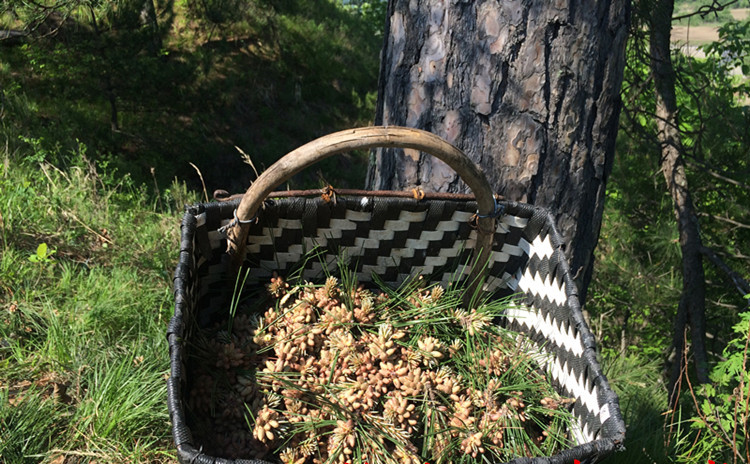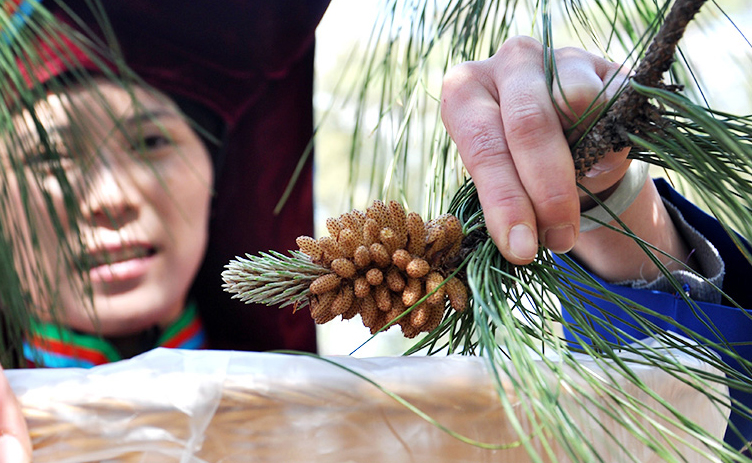The principal raw materials of Pine Pollen are from pollens of Chinese Pinus Massoniana Lamb which is a unique native species of pine tree in China, and it enjoys an exceptional advantage and reputation in terms of resource availability with a long history in TCM application. The areas in which it mostly grows range from Huai River and Tsinling Mountains in the north, to southern parts of Guangdong, Guangxi and Yunnan provinces in the south, southeast coastline and Taiwan in the east, and central parts of Guizhou and Sichuan provinces in the west, covering 17 provinces. It can be found in more than a half part of China, with the total resource in the area south to Huai River and Tsinling Mountains alone exceeding 20,000,000 hectares. Chinese Pinus Massoniana Lamb blooms in the spring every year. Each male cone produces about 157, 600 pollen particles. Each sprout produces 0.61g pollen on average, each square meter of tree crown 90.68g, and each hectare of plantation 755.7kg. Therefore, it is estimated that the annual yield of pollen from it alone could exceed 1, 500,000 tons in China.
Throughout April, we collect raw pine pollen from two sites each year, one in the Qiandao Lake area of Zhejiang Province and the other in Yunnan Province in southwestern China.
The Qiandao Lake/Thousand Island Lakes area is located in Chun’an County, Zhejiang Province, east of China. More than 90% of these areas are forests and Pinus massoniana is widely distributed. It is a national water resources protection area with excellent environmental conditions, and also a national 5A scenic spot.
Locals in Chun’an County have long been accustomed to picking and taking pine pollen powder, but it is only a primary raw food additive. According to the research of pine pollen conducted by the Chinese Academy of Forestry, a small number of farmers in Jinfeng and Wangzhai towns began collecting the pine pollen in 1984. Even now, the two towns are still the main collectors of pine pollen powder. In recent years, more villages and towns in Chun’an County have joined the pine flower harvesting team, such as the villages of Songcun, Zuokou, Wutong and Jiangjia, Linqi and so on.
The geographical position of Chun’an County is at the northeast of the subtropical zone, located at 29 degrees north latitude and 119 east longitude. And the annual average temperature is 17 degrees Celsius, the daily maximum temperature is about 39 degrees Celsius, the daily minimum temperature is about minus 5.4 degrees Celsius, the annual precipitation is about 1430mm, and the annual sunshine is about 1951 hours. The terrain is dominated by low and middle mountains, forming a distinct vertical climate layer. Because of the special microclimate formed by the water body effect of Qiandao Lake/Thousand Island Lakes, compared with other areas in the same latitude, it is warm in winter and cool in summer. Such climate conditions are conducive to the growth, development, flowering and fruiting of Pinus massoniana and are suitable for the production of pine pollen powder.
The area covers a wide amount of mountain red soil developed by gravel rock, which is suitable for the growth of Pinus massoniana. Pinus massoniana can blossom and bear fruit at the age of 2-3, but it takes 5-7 years to enter the normal blooming period. The pine pollen panicles gradually mature in early and mid April each year. This period lasts about 15 days, during which most of the harvest takes place. If it rains a lot during the flowering season, the harvest time may be shorter. On average, a farmer can harvest 2.5 to 5 kilograms of pine pollen powder a day. The forest area of Pinus massoniana in the Qiandao Lake/Thousands Island Lakes area is about 906,666 hectares, and annual output of pine pollen powder can reach to about 1,000 tons.
Yunnan Province in Southwestern China–an area roughly 152,000 sq miles, with the northwestern region displaying impressive mountain ranges and river valleys–including the vast pine forests. This part of Yunnan is the Tibet Autonomous Zone and is the foot of the most eastern edge of the Himalayan Mountains. This is where our pine pollen is gathered once a year. The Yunnan Province is home to the richest plant life of all of China and has been a top destination for many naturalists from the US and Europe because of its natural beauty and diverse plant and animal life. Because of the geographic isolation and the geographic nature of the northwestern area of Yunnan Province, the forests where our pine pollen is harvested from are far from industrial contamination. You can also view the video on YouTube to show you WHERE AND HOW IS OUR PINE POLLEN BEEN HARVESTED.
